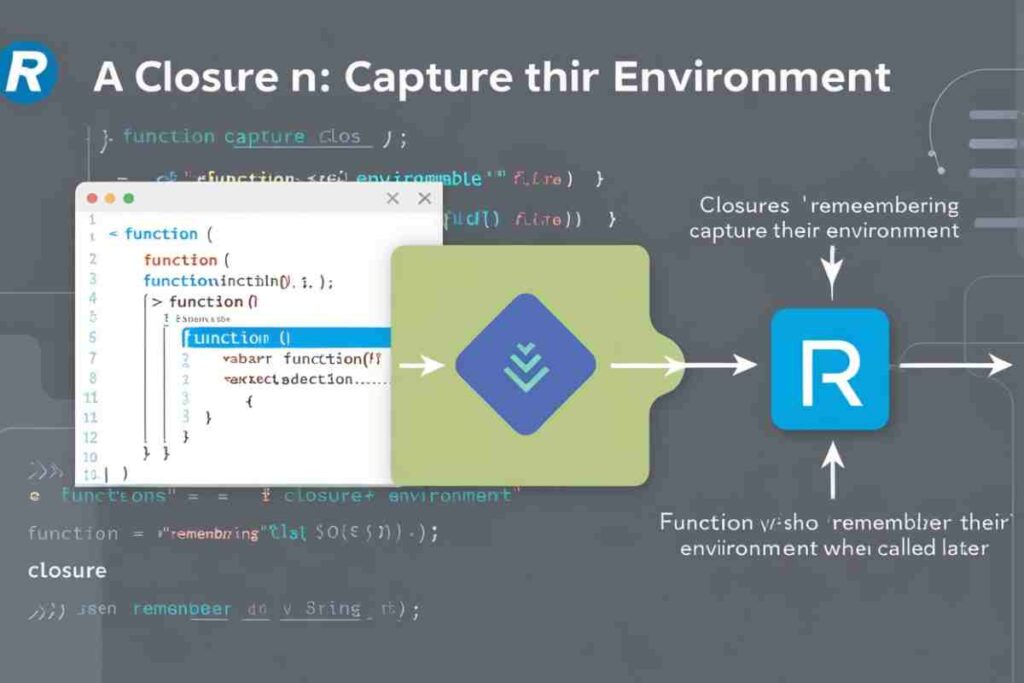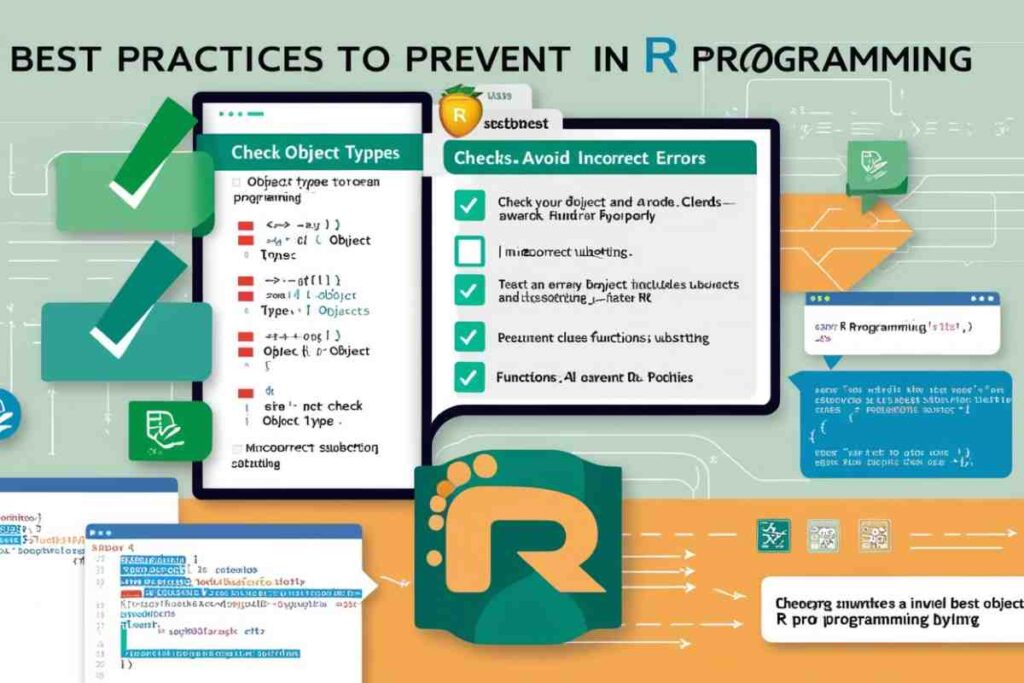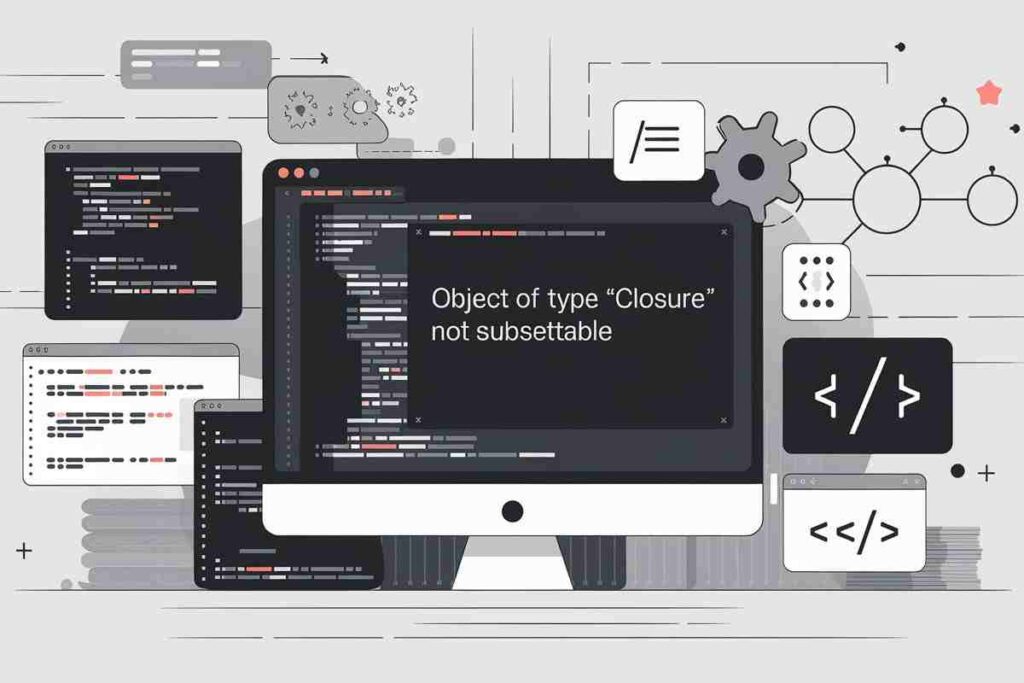If you’re working in R, you might have encountered the frustrating error message: “Object of type ‘closure’ is not subsettable,” which can cause confusion.
This issue occurs when you attempt to subset an object in R that is classified as a closure (a function) rather than a more common data structure like a vector or data frame.
Understanding why this happens and how to resolve it is essential for smooth coding, especially when dealing with complex data structures and functions in R.
In this post, we’ll explain why you see the “Object of type ‘closure’ is not subsettable” error in R, how to identify it, and offer potential solutions to avoid running into this issue in the future.
What is a Closure in R?

Before diving into the error itself, it’s helpful to understand what a closure is. In R, a closure is a function that captures the environment in which it was created, allowing the function to remember values from that environment when it is called later. Closures are powerful features in R, enabling functional programming and other advanced techniques.
In simpler terms, a closure is a function that can be treated as an object, meaning it has its own associated environment and variables. For example:

Here, my_function is a closure. However, if you attempt to subset it like a vector or data frame, such as my_function[1], you’ll get the error "Object of type 'closure' is not subsettable."
Why Does the Error Occur?
The “Object of type ‘closure’ is not subsettable” error occurs because in R, closures are treated as functions, not data structures. Unlike vectors, lists, or data frames, which support subsetting via indices or names, functions (closures) do not. Functions cannot be indexed using the square brackets [], which is a key feature of subsetting in R.
For instance, if you have a closure my_function and you try:

R does not know how to subset a function since functions are not subsettable objects. This is why the error message appears. The solution, therefore, is understanding when you’re working with a function and how to handle it correctly.
Subsetting Errors in Different Contexts
The error “Object of type ‘closure’ is not subsettable” can occur in various situations in R, and it can sometimes appear in different forms. For example:
- “Object of type closure is not subsettable in React”: If you’re using R with the
reactiveprogramming model in Shiny apps or working with React components in JavaScript-based frameworks, similar issues can arise. - “Cannot coerce type ‘closure’ to vector of type ‘character'”: This error occurs when you mistakenly try to coerce a function into a character vector, which is not supported.
- “Error in x$theme: object of type ‘closure’ is not subsettable ggsave”: This issue typically arises when you’re using
ggsave()with a non-subsettable closure, such as a plot function, and attempt to use it incorrectly.
Each of these cases essentially comes down to attempting to subset or manipulate a function (closure) as if it were a vector or data frame.
Troubleshooting the “Object of Type ‘Closure’ is Not Subsettable” Error
Here are some common scenarios where this error occurs and how to resolve them:
Accessing a Function as an Object
Often, users try to treat functions like regular objects. For example:

In this case, since my_function is a function and not a vector or list, R will throw the “Object of type ‘closure’ is not subsettable” error.
Solution: If you want to call the function, you should pass an argument to it, like so:

Incorrect Use with ggsave
The ggsave function is used for saving plots, but it might cause issues when incorrectly using a closure. If you’re attempting to subset or modify a plot object that is a function, you will encounter this error.

Solution: You should pass the plot object (the result of executing the function) directly into ggsave():

Subsetting within Shiny
In Shiny apps, you may face this error when attempting to subset reactive expressions or closures. For example:

Solution: Reactive expressions, such as renderPlot(), are closures. They need to be invoked correctly within the Shiny app’s lifecycle. You should not attempt to subset them directly.

Using apply Functions on Closures
When you’re working with apply functions like lapply or sapply and accidentally use a closure, you might see this error. For instance:

Solution: Ensure that the object you are applying a function to is an appropriate data structure. If my_function is a closure, pass an actual data frame, vector, or matrix.

Preventing the Error: Best Practices

To avoid encountering the “Object of type ‘closure’ is not subsettable” error, follow these best practices:
- Know When You’re Using Functions: Always check the type of object you’re working with using the
typeof()orclass()functions. Make sure you are not accidentally treating a function as a data structure.

- Proper Function Invocation: Ensure that functions are always invoked properly (i.e., with parentheses and arguments) and not treated as objects to be indexed or subsetted.
- Use Appropriate Subsetting: Use proper subsetting techniques for vectors, lists, or data frames, but avoid trying to index functions or closures.
- Check for Errors in Package Functions: If you’re using libraries like
ggplot2orShiny, ensure that you’re following their documentation carefully to understand how to use functions likeggsave()orrenderPlot()without subsetting closures.
Conclusion
The error “Object of type ‘closure’ is not subsettable” is a common issue in R that arises when attempting to treat functions (closures) as if they were vectors or data frames.
By understanding the nature of closures and following best practices for subsetting and function calls, you can avoid this error and ensure your code runs smoothly.
Whether you’re working with React in R, using ggsave() for plotting, or developing Shiny apps, being aware of this issue and troubleshooting it efficiently is key to becoming proficient in R programming.
FAQs
What is the “Object of type ‘closure’ is not subsettable” error?
This error occurs when you try to subset a function (closure) using square brackets, which is not allowed in R.
How do I fix the “Object of type ‘closure’ is not subsettable” error?
Ensure you’re not trying to subset a function. Instead, call the function with appropriate arguments.
What is a closure in R?
A closure is a function that captures its surrounding environment and can be called later with remembered values.
Can I use square brackets with a closure?
No, closures (functions) cannot be subsetted using square brackets. They need to be invoked with parentheses.
How can I check if an object is a closure?
Use the typeof() or class() function to check the type of an object. A closure will return "closure".
What happens if I try to subset a closure in Shiny?
In Shiny, closures like renderPlot() cannot be subsetted. You should call them with parentheses instead.
Can closures be used in ggsave()?
Closures can’t be directly used in ggsave(). You need to call the function to generate the plot before saving it.
What does “Object of Type ‘Closure’ is Not Subsettable” mean in R?
The error “Object of Type ‘Closure’ Not Subsettable” occurs when you try to subset a function (closure) using square brackets, which is not allowed in R.




